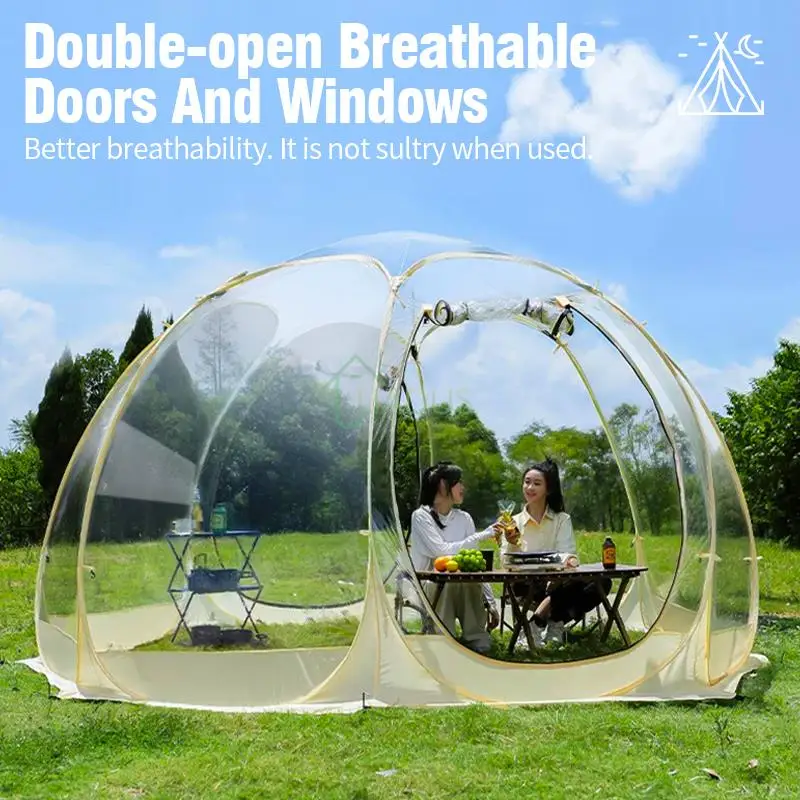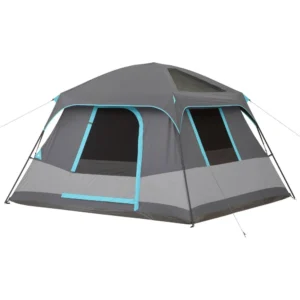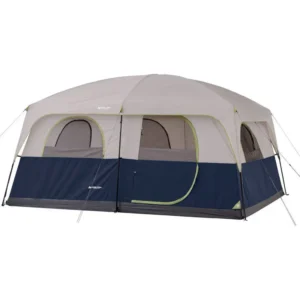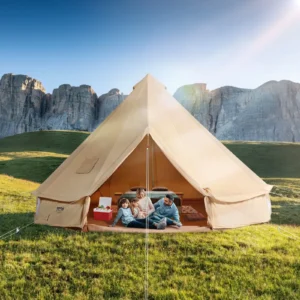Why Height Matters in Camping Tents
Anyone who’s ever hunched over inside a small tent knows the frustration of cramped camping quarters. Tent height isn’t just a luxury—it’s a fundamental aspect of comfort that can transform your outdoor experience from merely tolerable to genuinely enjoyable.
When you can stand upright in your tent, the entire camping experience changes. Simple tasks like changing clothes, organizing gear, or simply stretching after a long hike become effortless rather than exercises in contortion. For adults—especially those over 5‘10” (178 cm)—standard tents often create a stooped, uncomfortable experience that can lead to back strain and frustration.
The benefits of taller tents extend beyond just physical comfort:
- Reduced claustrophobia: Spacious interiors create a more open, relaxing environment
- Improved air circulation: Higher ceilings allow hot air to rise above sleeping areas
- Better organization: Vertical space enables more efficient storage solutions
- Enhanced livability: Makes the tent a true living space rather than just a sleeping quarters
- Accommodation for taller campers: Ensures everyone can use the space comfortably
Studies show the average American male stands at about 5‘9” (175 cm), while many standard tents offer peak heights of only 48-52 inches (122-132 cm)—forcing most adults to crouch. A “tall” tent typically offers at least 6 feet (183 cm) of center height, with some cabin models reaching over 7 feet (213 cm).
Understanding these dimensions is just the first step in selecting the right shelter. The fundamentals of shelter options for two campers apply here as well, but with special attention to vertical space requirements.
Key Features to Look for in Tall Camping Tents
When shopping for a tall camping tent, several specific features determine just how comfortable the living space will be for adult campers.
Peak Height Measurements
A tent’s peak height tells you the maximum interior height, typically measured at the center point. However, this can be misleading—a 6‘6” (198 cm) peak height might only exist in a small central area if the walls slope dramatically. Look for tents that specify their “standing area” or “standing room” dimensions to understand the usable tall space.
Wall Design
The wall design dramatically impacts usable space:
- Vertical walls: Cabin-style tents with near-vertical walls provide maximum usable height throughout the tent
- Sloped walls: Traditional dome tents have height that quickly diminishes as you move from center to edges
- Hybrid designs: Many modern tents combine elements, offering steeper walls with dome-like tops
Floor Dimensions
For tall sleepers, floor length is critical. Look for floor dimensions of at least 90 inches (229 cm) in length for comfortable sleeping without touching tent walls. The question of is a 2-person tent actually big enough becomes especially relevant for tall campers, who often need to size up to ensure adequate length.
Entrance Design
Door height and design significantly impact comfort. Look for:
* Doors at least 5‘8” (173 cm) tall
* D-shaped or rectangular doors rather than smaller triangular entrances
* Vestibules with sufficient height for ease of entry and exit
Internal Height Distribution
Some tents concentrate height in one zone (typically the center), while others distribute it more evenly. Extended dome designs, tunnel tents, and cabin models typically offer more consistent height throughout the interior space.
Structural Elements
The pole structure determines both stability and height. More advanced pole configurations with additional crossing points or curved extensions can create steeper walls and more overhead space.
For the widest selection and range of styles, exploring dedicated tall stand-up camping tent collections offers the best options specifically designed with height in mind.
Top 6 Tall Camping Tents for Adults
Here’s a comparison of some of the finest tall tents available:
| Model | Peak Height | Floor Dimensions | Weight | Capacity | Price Range | Best Use |
|---|---|---|---|---|---|---|
| Basecamp Elite | 7‘0” (213 cm) | 10’ × 10’ (305 × 305 cm) | 23 lbs (10.4 kg) | 6-person | $$$$ | Family camping |
| Highland Peak | 6‘8” (203 cm) | 8‘6” × 8‘6” (259 × 259 cm) | 18 lbs (8.2 kg) | 4-person | $$$ | Car camping |
| Summit Cabin | 6‘10” (208 cm) | 9’ × 7’ (274 × 213 cm) | 20 lbs (9.1 kg) | 4-person | $$$ | Extended stays |
| Trail Master | 6‘6” (198 cm) | 8’ × 7’ (244 × 213 cm) | 12 lbs (5.4 kg) | 3-person | $$ | Versatile use |
| Adventure Dome XL | 6‘4” (193 cm) | 8’ × 8’ (244 × 244 cm) | 15 lbs (6.8 kg) | 4-person | $$ | Wind resistance |
| EcoVenture Tunnel | 6‘5” (196 cm) | 12’ × 8’ (366 × 244 cm) | 17 lbs (7.7 kg) | 5-person | $$$ | Group camping |
Basecamp Elite
This cabin-style tent provides exceptional standing room across nearly the entire floor area. The near-vertical walls maximize usable space, making it ideal for families with members of varying heights. Six large windows provide excellent ventilation, while the room divider offers privacy when needed.
Highland Peak
With its hybrid design combining cabin and dome elements, the Highland Peak creates impressive headroom while maintaining good stability in windy conditions. The unique pole structure pushes height outward from the center, creating a larger standing zone than most comparable tents.
Summit Cabin
Purpose-built for tall campers, this model features extra-high doors (6‘6”/198 cm) in addition to its generous peak height. The extended awning over the door creates a small covered outdoor space that maintains headroom even when stepping outside.
Trail Master
While offering slightly less height than others, the Trail Master balances standing room with a more manageable weight, making it more portable than pure cabin designs. Its steeper-than-average walls create better headroom throughout.
Adventure Dome XL
This tent proves that dome designs can still offer good height when properly engineered. The reinforced pole structure creates a broader high area at the center while maintaining excellent stability in adverse weather conditions.
EcoVenture Tunnel
The elongated tunnel design provides consistent height throughout its length rather than just at a central peak. This makes it excellent for group camping where multiple people need standing room simultaneously.
Understanding the benefits of high ceiling tents can help you appreciate the significant advantages these models offer beyond mere specifications.
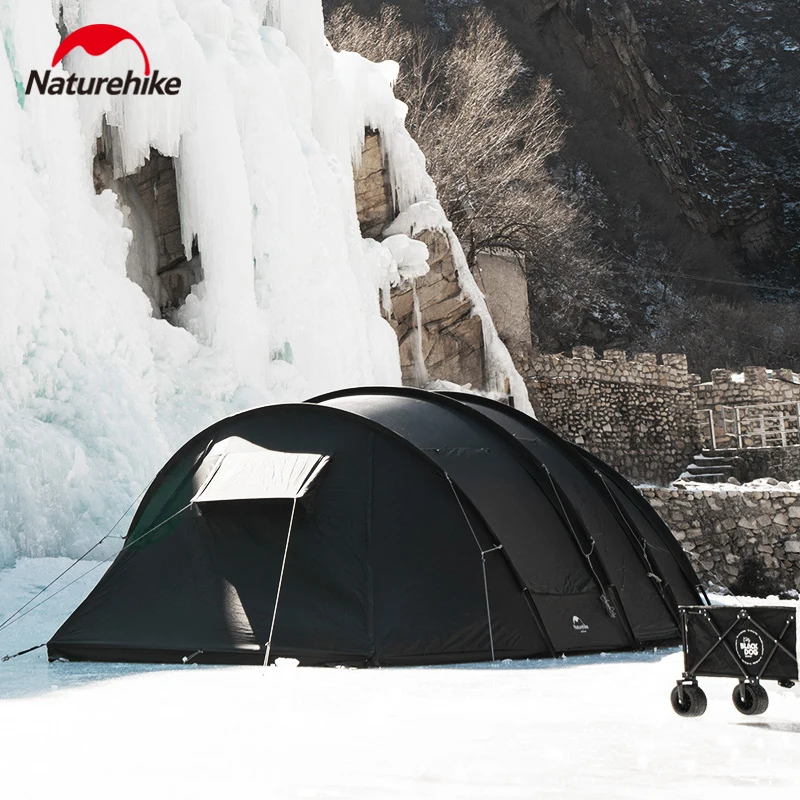
Cabin-Style Tents: Maximum Headroom for Tall Campers
When it comes to maximizing headroom, cabin-style tents reign supreme. These structures feature nearly vertical walls that extend the peak height across much more of the floor area, creating living spaces that feel more like rooms than traditional tents.
Advantages for Tall Campers
- Consistent ceiling height from center to edges (often 80% of peak height maintained throughout)
- Wall angles of 75-85 degrees versus the 30-45 degrees of traditional dome tents
- Room-like interior feel with defined corners and straight walls
- Superior organization potential with hanging storage and wall attachments
- Multiple room configurations enabling separate living and sleeping areas
The boxed shape of cabin tents creates a dramatic increase in usable space. For example, a dome tent and cabin tent with identical footprints and peak heights might differ by 30-40% in terms of usable standing area.
Notable cabin tent options include:
- Basecamp Elite with 7’ (213 cm) height throughout 90% of its interior
- Summit Lodge featuring room dividers and two 6‘6” (198 cm) tall doorways
- Highland Expedition with reinforced vertical wall construction
While cabin tents excel in headroom, they do have limitations. Their boxy shape catches wind more readily than aerodynamic designs, making them less ideal for exposed campsites. They’re also typically heavier and more complex to set up than similar-sized dome models.
For those seeking maximum space, exploring canvas camping tent options often provides excellent height alongside superior durability. Similarly, two-room camping tent designs offer separated living spaces with impressive headroom throughout.
Dome and Tunnel Tents: Finding Height in Alternative Designs
While cabin tents offer maximum headroom, innovative dome and tunnel designs are closing the gap with clever engineering that creates more usable height than traditional models.
Modern Dome Tent Innovations
Today’s advanced dome tents incorporate significant improvements for tall campers:
- Extended dome designs feature flattened top sections that broaden the peak area
- Hub-based pole structures push height outward from the center point
- Hybrid dome-cabin systems combine dome stability with steeper walls
- Multi-crossing pole configurations create more defined interior spaces
The Adventure Dome XL mentioned earlier demonstrates how modern engineering extends usable height in dome designs, offering a peak height of 6‘4” (193 cm) with a standing area covering about 40% of the floor space.
Tunnel Tent Advantages
Tunnel tents provide a different approach to height, creating consistent elevation along their length rather than concentrated at a center point:
- Uniform height along the central axis creates a corridor of standing room
- Multiple poles maintain height along the length rather than just at a single point
- Better height-to-weight ratio than many cabin designs
- Superior wind performance compared to tall cabin models
The elongated design of tunnel tents makes them particularly suitable for group camping, providing standing room for multiple people simultaneously without crowding.
For a wide selection of options with various height configurations, exploring dome camping tent collections offers excellent choices suitable for different camping styles.
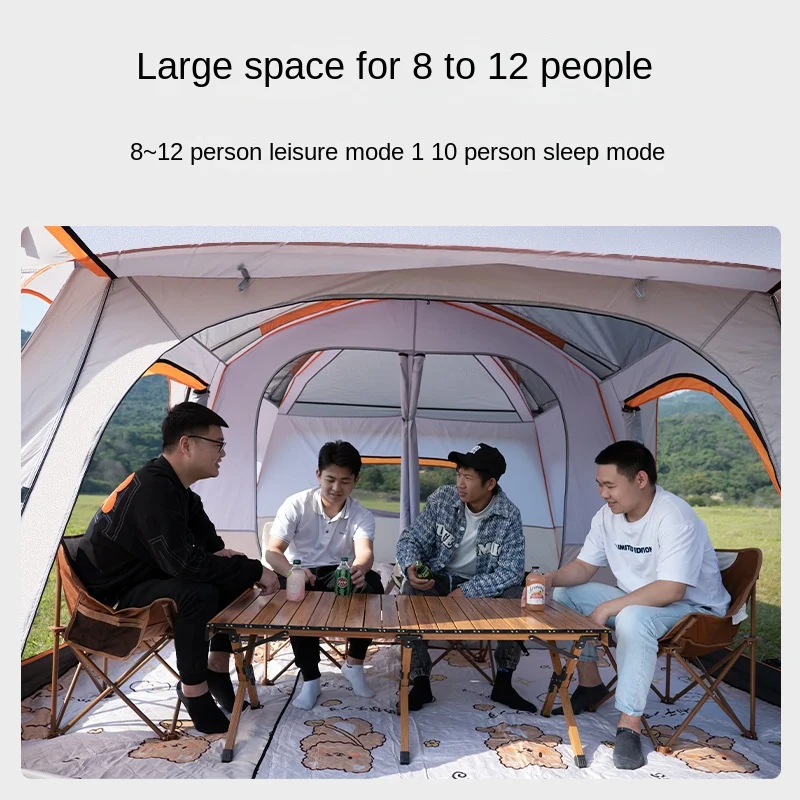
Setting Up Tall Tents: Tips for Stability and Maximum Height
The height advantage of tall tents can be compromised without proper setup. Follow these guidelines to ensure you achieve maximum headroom while maintaining stability:
- Select level ground with adequate space for all guy lines and stakes
- Assemble poles completely before insertion to ensure proper tension and shape
- Extend poles fully during setup to achieve maximum design height
- Use all provided stake points and guy lines to create proper tension
- Position the tent with its lowest profile facing prevailing winds when possible
- Tighten rainfly evenly to prevent sagging that reduces interior height
- Adjust interior hanging points to maximize clearance for tall campers
Common mistakes to avoid include:
* Insufficient staking leading to partial collapse during weather events
* Improper tensioning creating uneven wall angles
* Inadequate guy line deployment reducing stability in wind
* Rainfly installation that compresses the inner tent
For multi-person tents, the techniques for mastering two-person lightweight tent setup apply to larger models as well, with additional attention to proper tensioning across larger surfaces.
Essential Accessories for Tall Camping Tent Comfort
To maximize the comfort advantage of your tall tent, consider these specialized accessories:
- Extra-long sleeping pads (80”+ or 203+ cm) prevent feet from extending beyond padding
- Oversized cots (85”+ or 216+ cm) elevate tall campers while providing full-length support
- Collapsible furniture designed for tent interiors maximizes limited floor space
- Vertical storage systems with adjustable hanging points utilize upper wall space
- Extended sleeping bags (86”+ or 218+ cm) accommodate taller body frames
- Ceiling-mounted lighting systems provide better illumination in taller spaces
- Oversized footprints protect the entire tent floor area from moisture and abrasion
The right accessories enhance your tall tent’s functionality while preserving the space advantages it offers. For specific height recommendations based on camper height, the standing height tent guide provides detailed measurements for optimal comfort.
Weather Considerations for Tall Camping Tents
The increased height of tall camping tents creates specific considerations for weather performance:
Wind Resistance Challenges
Taller tents catch more wind and may require additional stabilization:
* Additional guy points are crucial for stability
* Proper staking becomes even more critical
* Wind-facing profiles should be minimized when possible
* Pole strength must be proportionally greater to handle additional force
Rain Management
Taller tents must efficiently channel water:
* Full-coverage rainflies should extend adequately over vertical walls
* Steeper rainfly angles help prevent pooling on larger surface areas
* Multiple tie-out points prevent sagging and water collection
* Proper ventilation becomes crucial to manage condensation in larger volumes
Seasonal Considerations
While most tall tents are 3-season designs, some 4-season winter 2-person tents offer surprising headroom while maintaining winter performance. These specialized designs use stronger pole materials and strategic reinforcement to support snow loads while preserving interior space.
For year-round camping, consider how different seasons affect your height needs. Summer camping often benefits most from maximum height for ventilation and comfort during longer periods spent inside during daylight hours.
Tall / Stand Up Camping Tent, Two Room Camping Tent
$407.93 Select options This product has multiple variants. The options may be chosen on the product pageHeavy Duty 4 Season Tent, Mountaineering Tent, Winter Camping Tent
$870.40 Select options This product has multiple variants. The options may be chosen on the product pageUltralight Backpacking Tent, Ultralight Dome Tent, Winter Camping Tent
Price range: $369.63 through $370.07 Select options This product has multiple variants. The options may be chosen on the product pageHeavy Duty 4 Season Tent, Ultralight Freestanding Tent, Winter Camping Tent
$3,722.66 Select options This product has multiple variants. The options may be chosen on the product page- $476.52 Select options This product has multiple variants. The options may be chosen on the product page
- $1,221.93 Select options This product has multiple variants. The options may be chosen on the product page
Can Tall Backpacking Tents Exist? Exploring the Weight-Height Tradeoff
The relationship between tent height and weight presents a significant challenge for backpackers. Every inch of additional height typically adds weight through longer poles, more fabric, and reinforced structures.
The Height-Weight Balance
Modern materials have somewhat mitigated this tradeoff:
* Advanced aluminum alloys create stronger, lighter poles
* Silnylon and similar fabrics reduce weight while maintaining durability
* Hybrid designs optimize pole configurations for better height-to-weight ratios
The best compromise options typically offer seated height (42-48 inches/107-122 cm) rather than standing height, with the lightest backpacking tents that provide this modest headroom weighing around 4-5 lbs (1.8-2.3 kg).
Alternative Solutions
When true standing height isn’t feasible, consider:
* Hammock setups with rainflies providing standing room adjacent to sleeping areas
* Tarp configurations with adjustable center poles for seated/standing comfort
* Hybrid shelter systems combining minimal sleeping tents with separate communal spaces
For most backpackers, the weight penalty of true standing height (typically 10+ additional pounds/4.5+ kg) remains prohibitive for long-distance hiking, making various types of tall tents for car camping more practical for situations where vehicle transport is available.
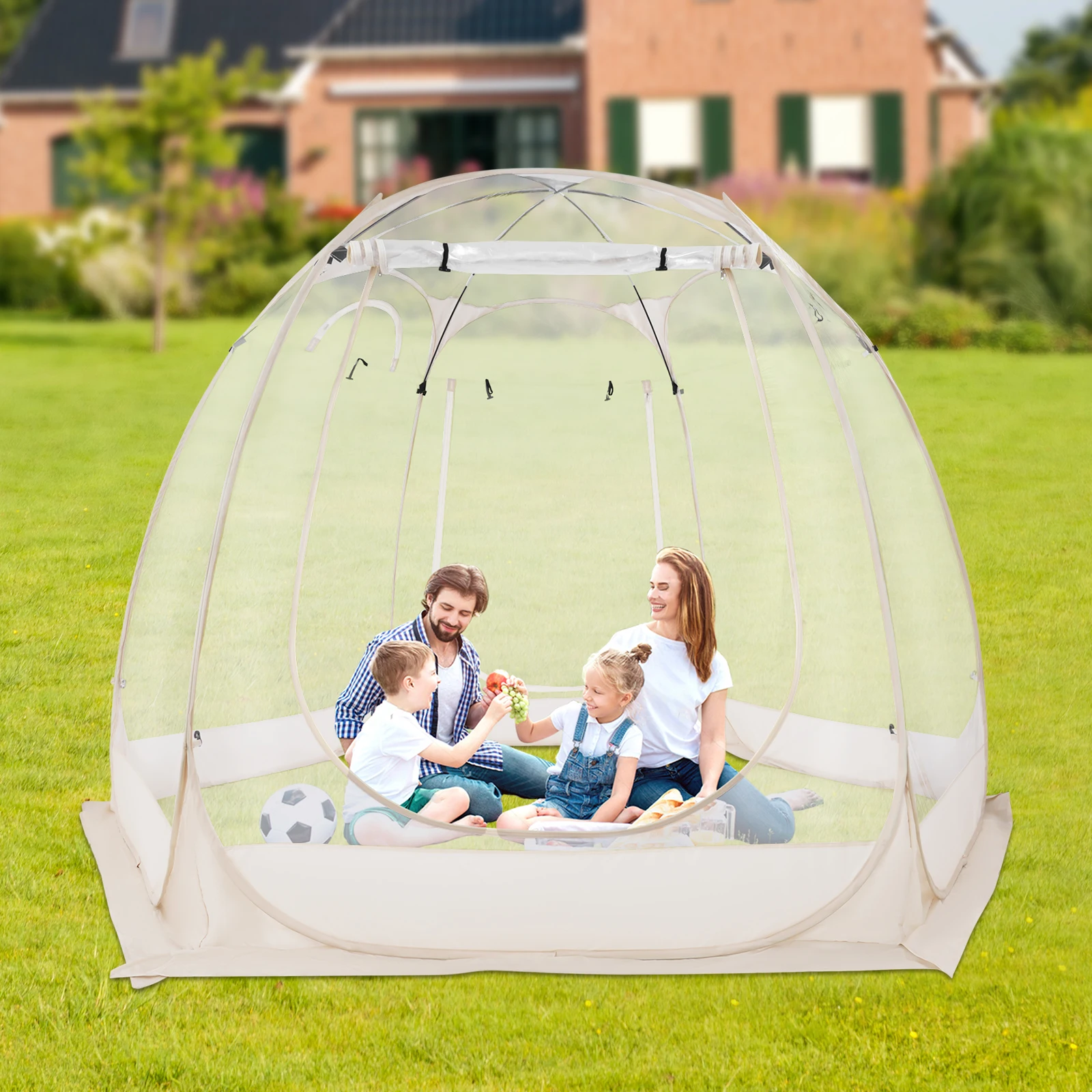
Frequently Asked Questions about Tall Camping Tents
What is considered a “tall” camping tent?
A tall camping tent typically offers at least 6 feet (183 cm) of center height. For campers over 6‘2” (188 cm), look for tents with 6‘6” (198 cm) or more of interior height. The most spacious cabin tents can reach 7’+ (213+ cm).
Do tall tents sacrifice other important features?
While tall tents excel in headroom, they may compromise on weight, pack size, and wind resistance. Many manufacturers offset these disadvantages with stronger materials and advanced design features, though usually at a higher price point.
Are tall tents harder to set up?
Generally, yes. More height typically means more poles, complex structures, and larger rainflies. However, many tall tent models now incorporate color-coded poles, unified frame systems, and intuitive designs that simplify setup despite their size.
How much extra should I expect to pay for a tall tent?
Expect a 15-30% price premium for tall models compared to standard-height equivalents. This reflects the additional materials and engineering required to create stable, weather-resistant structures with greater height.
Can tall tents handle strong winds?
With proper setup and appropriate design, yes. Cabin styles are most vulnerable to wind, while tall dome and tunnel designs offer better aerodynamics. Always use all guy lines and stake points, and position the lowest profile toward prevailing winds.
What floor length do I need as a tall sleeper?
For comfortable sleeping, the tent floor should be at least 12” (30 cm) longer than the height of the tallest camper. For someone 6‘3” (190 cm), look for floor lengths of at least 86” (218 cm), preferably 90”+ (229+ cm).
Are instant/pop-up tents ever tall enough?
Yes, several instant camping tent models now offer standing height with setup times under 2 minutes. However, these typically weigh more than traditional pole tents and may have slightly less stability in adverse conditions.
Is a Tall Tent Worth the Investment for Family Camping?
For family camping adventures, tall tents offer compelling advantages that often justify their premium price points.
Pros:
- Accommodates family members of all heights comfortably
- Creates a genuine living space that enhances extended stays
- Allows full movement during inclement weather when confined indoors
- Simplifies changing clothes and childcare activities
- Improves air circulation during hot weather
- Better accommodates common family gear and activities
Cons:
- Higher initial investment (typically 20-30% more)
- Larger packed size requires more cargo space
- Heavier weight makes transportation more challenging
- Potentially more complex setup may extend camp preparation time
- May require larger tent pads at developed campgrounds
For most families, especially those with teenagers or adults over 5‘10” (178 cm), the comfort advantages of tall tents significantly enhance the camping experience during longer stays. The value increases with trip duration—weekend campers might find the premium less worthwhile than those spending a week or more outdoors.
When traveling with smaller groups, understanding camping shelter options for two can help determine whether a specialized tall tent is necessary or if other configurations might better serve your needs.
At Explore Elements, we believe that comfortable camping leads to more memorable outdoor experiences. The right tall tent transforms camping from merely sleeping outdoors to truly living in nature—standing up, stretching out, and enjoying the outdoors without compromise.

